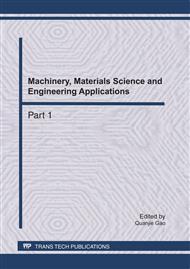[1]
N. XU, M. SUN, Y. W. CAO, J. N. Yao and E. G. Wang: Appl. Surf. Sci., Vol. 1-2 (2000), p.81.
Google Scholar
[2]
R. Bussjager, J. Chaiken, M. Getbehead, D. Grusza, D. Hinkel, T. Mcewen, J. Osman and E. Voss: Jpn. Appl. Phys., Part 1, Vol. 39 (2000), p.789.
DOI: 10.1143/jjap.39.789
Google Scholar
[3]
M. Sun, N. Xu, J. W Cao, J. N. Yao and E. C. Wang: J. Mate. Res., Vol. 12 (2000), p.927.
Google Scholar
[4]
T. L. Royster, D. Chatterjee, G. R. Paz-pujalt and C. A. Marrese: Sens. Actuators B: Chemical, Vol. 53 (1998), p.155.
Google Scholar
[5]
D. S. Lee, K. H. Nam and D. D. Lee: Thin Solid Films, Vol. 375 (2000), p.142.
Google Scholar
[6]
B. P. Jelle and G. Hagen: Sol. Energy Mat. Sol. Cells, Vol. 58 (1999), p.277.
Google Scholar
[7]
E. M. Girotto and M. A. D. Paoli: J. Braz. Chem. Soc., Vol. 10 (1999), p.394.
Google Scholar
[8]
C. G. Granqvist: Sol. Energy Mat. Sol. Cells, Vol. 60 (2000), p.201.
Google Scholar
[9]
C. Trimble, M. Devries, J. S. Hale, D. W. Thompson, T. E. Tiwald and J. A. Woollam: Thin Solid Films, Vol. 356 (1999), p.26.
DOI: 10.1016/s0040-6090(99)00439-3
Google Scholar
[10]
K. H. Lee, Y. K. Fang, W. J. Lee, J. J. Ho, K. H. Chen and K. S. Liao: Sens. Actuators: B, Vol. 69 (2000), p.96.
Google Scholar
[11]
E. Llobet, G. Molas, P. Molinas, J. Calderer, X. Vilanova, J. Brezmes, J. E. Sueiras and X. Correig: J. Electrochem Soc., Vol. 147 (2000), p.776.
DOI: 10.1149/1.1393270
Google Scholar
[12]
C. Cantalini, W. Wlodarski, M. Passacantando, S. Santucci, E. Comini, G. Faglia and G. Sberveglieri: Sens. Actuators: B, Vol. 64 (2000), p.182.
DOI: 10.1016/s0925-4005(99)00504-3
Google Scholar
[13]
W. M. Qu and W. Wlodarski: Sens. Actuators: B, Vol. 64 (2000), p.42.
Google Scholar
[14]
F. B. Li, G. B. Gu, X. J. Li and H. F. Wan: Acta Phys. Chim. Sinica, Vol. 16 (2000), p.997.
Google Scholar
[15]
S. Anders, A. Anders, M. Rubin, Z. Wang, S. Raoux, F. Kong and I. G. Brown: Surf. Coat. Technol., Vol. 76 (1995), p.167.
Google Scholar
[16]
M. Suvanto, J. Raty and T. A. Pakkanen: Catal. Lett., Vol. 62 (1999), p.21.
Google Scholar
[17]
Z. R. Yu, X. D. Jia, J. H. Du and J. Y. Zhang: Sol. Energy Mat. Sol. Cell., Vol. 64 (2000), p.55.
Google Scholar
[18]
M. J. Okeefe, J. T. Grant and J. S. Solomon: J. Electron. Mater., Vol. 24 (1995), p.961.
Google Scholar
[19]
L. H. M Krings and W. Talen: Sol. Energy Mat. Cells., Vol. 54 (1998), p.27.
Google Scholar
[20]
Y. Tamou and S. Tanaka: Nanostruct. Mater., Vol. 12 (1999), p.123.
Google Scholar
[21]
N. Kumagai, K. Kozawa, N. Kumagai, S. Komaba and A. Derja: Denki Kagaku, Vol. 66 (1998), p.1223.
DOI: 10.5796/kogyobutsurikagaku.66.1223
Google Scholar
[22]
K. Huang, Q. Zhang, F. Yang and D. Y. He: Nano. Res., Vol. 3 (2010), p.281.
Google Scholar


